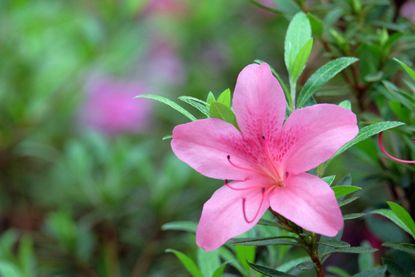When Can I Transplant Azaleas: Tips On Relocating An Azalea Bush


Azaleas are a favorite perennial for many gardeners because of their long lives and reliable flowering. Since they’re such a mainstay, it can be heartbreaking to have to get rid of them. It’s much more preferable to move them if at all possible. Keep reading to learn more about how to move an azalea bush and the best time for relocating azaleas.
When Can I Transplant Azaleas?
The best time for relocating an azalea bush really depends upon your climate. Azaleas are hardy in USDA zones 4 through 9, which is a very wide range as far as temperature. If you live in a lower numbered zone with cold winters, the best time for azalea transplanting is early spring, before new growth has started. This will give the roots a full growing season to become established before the bitter cold of winter, which can really damage a weak, newly-transplanted bush. If you’re growing in a hot climate, you have the opposite problem. The best time for transplanting azaleas is late summer or early autumn. Instead of bringing possible frost damage, winter provides safe, mild temperatures for your roots to get nice and established before the harsh heat of summer.
How to Move an Azalea Bush
Before you begin to move your azalea, you should find a new site for it and dig a hole there. The less time your plant has to spend out of the ground, the better. Pick a site that’s partially shady, moist, and well draining with a pH that’s slightly acidic. Next, dig a circle 1 foot (31 cm.) out from the trunk. If the shrub is really big, dig farther out. The circle should be at least 1 foot (31 cm.) deep, but probably won’t have to be much deeper. Azalea roots are shallow. Don’t worry if you cut through some roots-- it’s going to happen. Once you’ve dug your circle, use your shovel to lift the root ball out of the ground. Wrap the root ball in burlap to keep it moist and move it to its new hole immediately. The new hole should be the same depth as and twice the width of the root ball. Set the root ball inside and fill it in so the soil line is the same as in its old spot. Water thoroughly and keep watering at a rate of about 10 inches (25 cm.) per week until the plant becomes established.
Gardening tips, videos, info and more delivered right to your inbox!
Sign up for the Gardening Know How newsletter today and receive a free download of our most popular eBook "How to Grow Delicious Tomatoes."

The only child of a horticulturist and an English teacher, Liz Baessler was destined to become a gardening editor. She has been with Gardening Know how since 2015, and a Senior Editor since 2020. She holds a BA in English from Brandeis University and an MA in English from the University of Geneva, Switzerland. After years of gardening in containers and community garden plots, she finally has a backyard of her own, which she is systematically filling with vegetables and flowers.
-
 Grow a Bathroom Oasis: 8 Best Bathroom Plants With No Light or Low Light
Grow a Bathroom Oasis: 8 Best Bathroom Plants With No Light or Low LightSome apartment dwellers grow the best bathroom plants with no light or low light. Read how one of our favorite plant lovers does it in the big city.
By Teo Spengler
-
 "My Worst Mistake" – Gardeners Share 10 Hard-Learned Lessons
"My Worst Mistake" – Gardeners Share 10 Hard-Learned LessonsGardeners never stop learning, and sometimes our mistakes are the best teachers. But why not save time and heartache by learning from other gardeners' failures?
By Melanie Griffiths